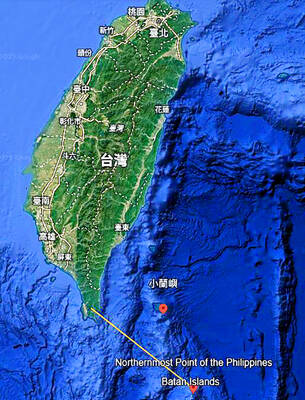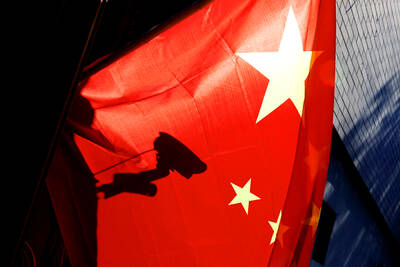China has increased its provocative incursions around Taiwan by 300 percent since May, US Commander of Pacific Air Forces General Kevin Schneider said in an interview published yesterday, adding that adversaries in the region could try to test the new administration of US president-elect Donald Trump.
“Whether it’s coming into the air defense identification zone [ADIZ] or crossing the center line within the Taiwan Strait, since the inauguration [of president William Lai (賴清德)], we have seen a 300 percent increase in those air activities,” Schneider told NBC News.
From May to November last year, Chinese aircraft intruded into Taiwan’s ADIZ 335 times, Ministry of National Defense data showed.

Photo: screen grab from the US Pacific Air Force Facebook page
In the same time frame this year, China intruded into that same airspace at least 1,085 times, more than three times as many as the previous year, NBC News reported.
The difference was more pronounced in the summer — 50 Chinese aircraft entered Taiwan’s ADIZ in July last year, while 210 entered it in July this year, more than four times as many, it said.
The Chinese People’s Liberation Army (PLA) Air Force has maintained the increased activity level since Lai was sworn in on May 20, Schneider said.
Liu Pengyu (劉鵬宇), a spokesman for the Chinese embassy in Washington, was quoted by NBC News as saying that the flights are fully consistent with international law and common practices, adding that “the PLA’s relevant drills are a necessary and legitimate move to crack down on ‘Taiwan independence’ separatist forces.”
Schneider said the biggest challenge he faces comes from Beijing, which is building a massive rocket force, air force, submarine force and cyberforce, which it uses to intimidate other nations in the region.
“It’s the behaviors that have gone along with that. It’s the bullying, the aggressiveness,” Schneider said.
“My assessment is it’s a pressurization campaign designed to win without fighting, and I think just to continue to impose costs, physical or otherwise, to present a fait accompli to the world,” he said. “Not just to Taiwan, but to the world that Beijing can accomplish their objectives, and they continue to ramp up their activities, military activities, in conjunction with diplomatic activities, informational activities, economic activities, to win without fighting.”
US intelligence officials have said that 2027 could be an inflection point for a cross-strait conflict, which would come during Trump’s second term in office, but the returning president has not committed to defending Taiwan during a Chinese invasion, NBC News reported.
It quoted Schneider as saying that 2027 as the year for possible action by Beijing is still uncertain, but added that China’s behavior has grown more aggressive and it is operating farther away from China.
Learning from how the US has operated in the Middle East, Beijing aims to push the US out of the region, while bolstering its military capabilities, the general said.
“We had the ability to take our time, to bring our forces into the theater, to build up large bases, to build up our capability and then at the time of our choosing, when we had the advantages of mass in place, were able to determine when we would go to conduct our operations,” he said. “I assess that Beijing has recognized that, and now they are building this capability to prevent us from ever being able to do that and replicating it.”
Adversaries in the region could try to test the new Trump administration in its early days, and opportunist “actors in the region may seek to challenge a new administration,” he said.
“It’s something that we on the military side are ready for, and we continue to provide options back to our national leadership,” he said.
Ultimately, the US is still focused on effective deterrence to prevent conflict in the region, Schneider said.
“And if that peace, stability and security is unilaterally upended by anyone in the region, then we will react, and we will react with a network of allies and partners that is incredibly capable,” he added.

SECURITY: As China is ‘reshaping’ Hong Kong’s population, Taiwan must raise the eligibility threshold for applications from Hong Kongers, Chiu Chui-cheng said When Hong Kong and Macau citizens apply for residency in Taiwan, it would be under a new category that includes a “national security observation period,” Mainland Affairs Council (MAC) Minister Chiu Chui-cheng (邱垂正) said yesterday. President William Lai (賴清德) on March 13 announced 17 strategies to counter China’s aggression toward Taiwan, including incorporating national security considerations into the review process for residency applications from Hong Kong and Macau citizens. The situation in Hong Kong is constantly changing, Chiu said to media yesterday on the sidelines of the Taipei Technology Run hosted by the Taipei Neihu Technology Park Development Association. With

A US Marine Corps regiment equipped with Naval Strike Missiles (NSM) is set to participate in the upcoming Balikatan 25 exercise in the Luzon Strait, marking the system’s first-ever deployment in the Philippines. US and Philippine officials have separately confirmed that the Navy Marine Expeditionary Ship Interdiction System (NMESIS) — the mobile launch platform for the Naval Strike Missile — would take part in the joint exercise. The missiles are being deployed to “a strategic first island chain chokepoint” in the waters between Taiwan proper and the Philippines, US-based Naval News reported. “The Luzon Strait and Bashi Channel represent a critical access

‘FORM OF PROTEST’: The German Institute Taipei said it was ‘shocked’ to see Nazi symbolism used in connection with political aims as it condemned the incident Sung Chien-liang (宋建樑), who led efforts to recall Democratic Progressive Party (DPP) Legislator Lee Kun-cheng (李坤城), was released on bail of NT$80,000 yesterday amid an outcry over a Nazi armband he wore to questioning the night before. Sung arrived at the New Taipei City District Prosecutors’ Office for questioning in a recall petition forgery case on Tuesday night wearing a red armband bearing a swastika, carrying a copy of Adolf Hitler’s Mein Kampf and giving a Nazi salute. Sung left the building at 1:15am without the armband and apparently covering the book with a coat. This is a serious international scandal and Chinese

COUNTERINTELLIGENCE TRAINING: The ministry said 87.5 percent of the apprehended Chinese agents were reported by service members they tried to lure into becoming spies Taiwanese organized crime, illegal money lenders, temples and civic groups are complicit in Beijing’s infiltration of the armed forces, the Ministry of National Defense (MND) said in a report yesterday. Retired service members who had been turned to Beijing’s cause mainly relied on those channels to infiltrate the Taiwanese military, according to the report to be submitted to lawmakers ahead of tomorrow’s hearing on Chinese espionage in the military. Chinese intelligence typically used blackmail, Internet-based communications, bribery or debts to loan sharks to leverage active service personnel to do its bidding, it said. China’s main goals are to collect intelligence, and develop a